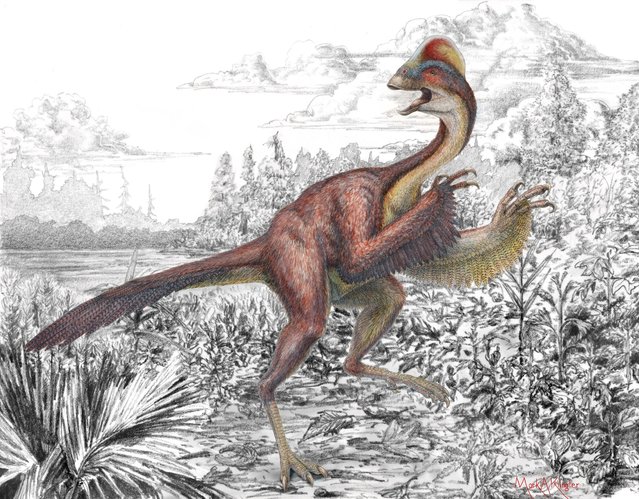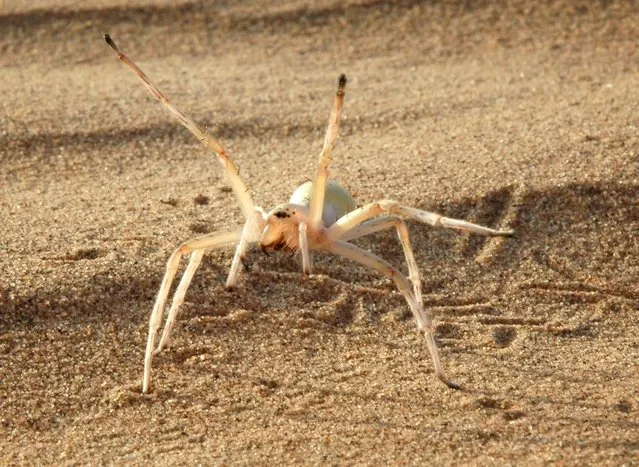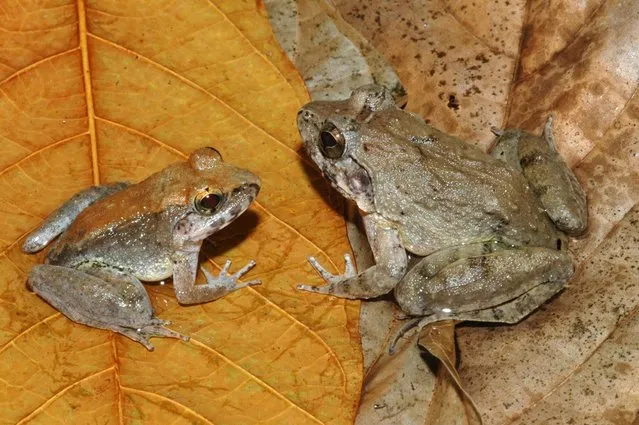Scientists named 18,000 new species in 2014 – but these 10 are a notch above the rest. From a spider that cartwheels away from its predators to a frog that gives birth to live tadpoles, the newly discovered animals on the top 10 list compiled by an international committee of taxonomists at the State University of New York College of Environmental Science and Forestry each have something that stands out. The list is released each year to honor the May 23 birthday of Carolus Linnaeus, an 18th-century Swedish botanist who is considered the father of modern taxonomy. “The Top 10 is a reminder of the wonders awaiting us”, said Dr. Quentin Wheeler, ESF president and founding director of the International Institute for Species Exploration.

Life reconstruction of the new oviraptorosaurian dinosaur species Anzu wyliei in its 66 million-year-old environment in western North America as seen in an undated handout illustration by Mark A. Klinger, Carnegie Museum of Natural History. Some 18,000 species, great and small, were discovered in 2014, adding to the 2 million already known, scientists said on May 21, 2015 as they released a “Top 10” list that highlights the diversity of life. Anzu wyliei, one of the top 10, dubbed “the chicken from hell”, is extinct. The feathered dinosaur whose partial skeletons were unearthed in the Dakotas was a contemporary of T. rex and Triceratops. (Photo by Mark A. Klingler/Reuters/Carnegie Museum of Natural History)

A Phryganistria tamdaoensis male stick insect is seen in an undated handout picture courtesy of Dr. Bruno Kneubuehler. While this new stick insect is not the world's longest, at nine inches, it belongs to a family known as giant sticks. (Photo by Jonathan Brecko/Reuters)

The sea slug Phyllodesmium acanthorhinum is seen in this undated handout picture by Robert Bolland. P. Acanthorhinum – seen as a 'missing link' between sea slugs that feed on hydroids and those specializing on corals – is one of SUNY College of Environmental Science and Forestry's “Top 10” species discovered in 2014. (Photo by Robert Bolland/Reuters)

The bromeliad Tillandsia religiosa is seen in this undated handout picture obtained by Reuters May 21, 2015. T. religiosa is one of SUNY College of Environmental Science and Forestry's “Top 10” species discovered in 2014. (Photo by A. Espejo/Reuters)

The cartwheeling spider, Cebrennus rechenbergi, is seen in this undated handout picture obtained by Reuters May 21, 2015. C. rechenbergi is one of SUNY College of Environmental Science and Forestry's “Top 10” species discovered in 2014. (Photo by Prof. Dr. Ingo Rechenberg/Reuters/Technical University Berlin)

A pair of pufferfish (Torquigener albomaculosus) are seen engaging in courtship behaviour in this undated handout picture obtained by Reuters May 21, 2015. T. albomaculosus is one of SUNY College of Environmental Science and Forestry's “Top 10” species discovered in 2014. (Photo by Yoji Okata/Reuters)

Dendrogramma enigmaticais seen in this undated handout picture obtained by Reuters May 21, 2015. 2. D. enigmatica is one of SUNY College of Environmental Science and Forestry's “Top 10” species discovered in 2014. (Photo by Jørgen Olesen/Reuters)

The Bone-house wasp Deuteragenia ossarium is seen in this undated handout picture obtained by Reuters May 21, 2015. D. ossarium is one of SUNY College of Environmental Science and Forestry's “Top 10” species discovered in 2014. (Photo by Michael Staab/Reuters)

The coral plant Balanophora coralliformi is seen in this undated handout picture obtained by Reuters May 21, 2015. B. coralliformi one of SUNY College of Environmental Science and Forestry's “Top 10” species discovered in 2014. (Photo by P.B. Pelser & J.F. Barcelona/Reuters)

A male (L) and female Indonesion frog (Limnonectes larvaepartus) are seen in Sulawesi in this undated handout picture obtained by Reuters May 21, 2015. L. larvaepartus is one of SUNY College of Environmental Science and Forestry's “Top 10” species discovered in 2014. (Photo by Jimmy A. McGuire/Reuters)
22 May 2015 12:31:00,
post received
0 comments
